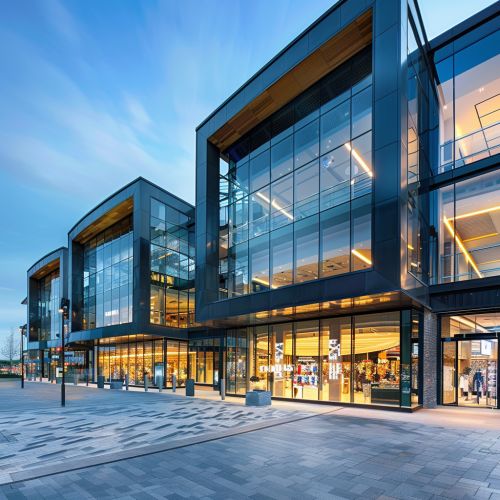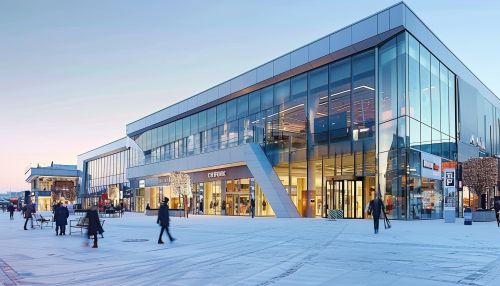Retail Building: Difference between revisions
(Created page with "== Introduction == A '''retail building''' is a structure designed and constructed specifically for the purpose of housing retail businesses. These buildings are integral to the commercial landscape and serve as the physical locations where goods and services are sold directly to consumers. Retail buildings vary significantly in size, design, and function, ranging from small standalone shops to large shopping malls. == Types of Retail Buildings == Retail buildings can b...") |
No edit summary |
||
| Line 17: | Line 17: | ||
Mixed-use developments combine retail spaces with other types of uses, such as residential, office, or [[hospitality]]. These buildings are designed to create a vibrant, multi-functional environment that attracts a diverse range of visitors. Examples include urban developments that integrate retail stores on the ground floor with apartments or offices above. | Mixed-use developments combine retail spaces with other types of uses, such as residential, office, or [[hospitality]]. These buildings are designed to create a vibrant, multi-functional environment that attracts a diverse range of visitors. Examples include urban developments that integrate retail stores on the ground floor with apartments or offices above. | ||
[[Image:Detail-79259.jpg|thumb|center|Modern shopping mall exterior with glass facades and multiple entrances.|class=only_on_mobile]] | |||
[[Image:Detail-79260.jpg|thumb|center|Modern shopping mall exterior with glass facades and multiple entrances.|class=only_on_desktop]] | |||
== Design and Architecture == | == Design and Architecture == | ||
Latest revision as of 18:25, 17 May 2024
Introduction
A retail building is a structure designed and constructed specifically for the purpose of housing retail businesses. These buildings are integral to the commercial landscape and serve as the physical locations where goods and services are sold directly to consumers. Retail buildings vary significantly in size, design, and function, ranging from small standalone shops to large shopping malls.
Types of Retail Buildings
Retail buildings can be categorized into several types based on their size, design, and the nature of the retail activities they support. The primary types include:
Standalone Stores
Standalone stores are individual retail buildings that operate independently of other retail establishments. These buildings are typically occupied by a single retailer and are often found in suburban or rural areas. Examples include convenience stores, supermarkets, and big-box stores.
Strip Malls
Strip malls, also known as strip centers, are a collection of retail stores arranged in a row, typically with a shared parking lot in front. These retail buildings are common in suburban areas and usually house a variety of small to medium-sized retailers, such as pharmacies, restaurants, and specialty shops.
Shopping Malls
Shopping malls are large retail complexes that house multiple retailers under one roof. These buildings often include anchor stores, which are large department stores or supermarkets that draw significant foot traffic. Shopping malls are designed to provide a comprehensive shopping experience, often including food courts, entertainment facilities, and various services.
Mixed-Use Developments
Mixed-use developments combine retail spaces with other types of uses, such as residential, office, or hospitality. These buildings are designed to create a vibrant, multi-functional environment that attracts a diverse range of visitors. Examples include urban developments that integrate retail stores on the ground floor with apartments or offices above.


Design and Architecture
The design and architecture of retail buildings play a crucial role in their functionality, aesthetic appeal, and ability to attract customers. Key considerations in the design of retail buildings include:
Layout
The layout of a retail building is essential for optimizing customer flow and maximizing retail space. Common layout designs include grid layouts, free-flow layouts, and racetrack layouts. Each layout type has its advantages and is chosen based on the retailer's specific needs and the type of products sold.
Facade
The facade of a retail building is the exterior face that presents the building to the public. A well-designed facade can attract customers and create a strong brand identity. Materials commonly used for facades include glass, metal, and brick. The design may incorporate large windows, signage, and architectural features to enhance visual appeal.
Accessibility
Accessibility is a critical aspect of retail building design. This includes ensuring that the building is easily reachable by various modes of transportation, providing ample parking, and complying with Americans with Disabilities Act (ADA) standards to accommodate all customers.
Sustainability
Sustainable design practices are increasingly important in retail building construction. This includes using energy-efficient materials, incorporating renewable energy sources, and implementing waste reduction strategies. Green building certifications, such as LEED (Leadership in Energy and Environmental Design), are often sought to demonstrate a commitment to sustainability.
Economic Impact
Retail buildings have a significant economic impact on local communities and the broader economy. They create jobs, generate tax revenue, and stimulate economic activity. The presence of retail buildings can lead to the development of surrounding areas, increasing property values and attracting additional businesses.
Job Creation
Retail buildings provide employment opportunities for a wide range of workers, including sales associates, managers, maintenance staff, and security personnel. The construction and maintenance of retail buildings also create jobs in the construction and service industries.
Tax Revenue
Retail buildings contribute to local and state tax revenues through property taxes, sales taxes, and business taxes. These revenues fund public services such as schools, infrastructure, and emergency services.
Economic Development
The development of retail buildings can stimulate economic growth in surrounding areas. Retail buildings attract consumers, which can lead to increased demand for other services, such as dining and entertainment. This, in turn, can attract additional businesses and investors to the area.
Challenges and Trends
The retail industry is constantly evolving, and retail buildings must adapt to changing consumer preferences, technological advancements, and economic conditions. Some of the key challenges and trends affecting retail buildings include:
E-commerce
The rise of e-commerce has significantly impacted traditional retail buildings. Many consumers now prefer to shop online, leading to decreased foot traffic in physical stores. Retail buildings must adapt by integrating online and offline shopping experiences, offering in-store pickup for online orders, and creating unique in-store experiences that cannot be replicated online.
Urbanization
As more people move to urban areas, there is a growing demand for retail buildings in city centers. Urban retail buildings often face challenges such as limited space, higher construction costs, and stricter zoning regulations. However, they also benefit from higher foot traffic and proximity to a dense population.
Technology Integration
Technology is transforming the retail experience, and retail buildings must incorporate new technologies to stay competitive. This includes implementing smart building technologies, such as automated lighting and climate control systems, as well as offering digital payment options and interactive displays.
Sustainability
There is a growing emphasis on sustainability in retail building design and construction. Retailers and developers are increasingly adopting green building practices to reduce their environmental impact and appeal to environmentally conscious consumers. This includes using sustainable materials, improving energy efficiency, and reducing waste.
Conclusion
Retail buildings are a vital component of the commercial landscape, providing spaces for businesses to sell goods and services directly to consumers. The design, construction, and operation of retail buildings involve numerous considerations, from layout and facade design to accessibility and sustainability. As the retail industry continues to evolve, retail buildings must adapt to changing consumer preferences and technological advancements to remain relevant and successful.
